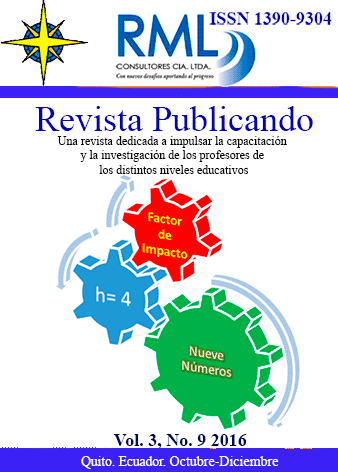Resumen
La investigación se propuso analizar el efecto del género en las variables que condicionan la intención de emprendimiento. La investigación se basó en una revisión bibliográfica empleando Sciencedirect para los términos “agricultural entrepreneurship”, “modelling agricultural entrepreneurship”. Se exploraron igualmente los términos “emprendimiento”, “entrepreneurship” . Se realizó un análisis de contenidos en relación con títulos y resúmenes que permitió determinar un total de 58 referencias.
A partir de la revisión bibliográfica realizada se pudo determinar que es de interés científico y actualidad poder establecer un modelo que permita determinar las relaciones entre las variables: propensión al riesgo, necesidad de logro, necesidad de independencia, intención de emprendimiento agrícola y el posible efecto del género sobre ellas. Este problema tiene interés especial para los países de América Latina en que se manifiesta una elevada tasa de emprendimiento femenino.
Referencias
Alonso, N., & Trillo, D. (2014). Women, Rural Environment and Entrepreneurship. Procedia - Social and Behavioral Sciences, 161, 149-155. doi:http://dx.doi.org/10.1016/j.sbspro.2014.12.039
Alvarez, C., & Urbano, D. (2011). Una Década de Investigación basada en el GEM: Logros y Retos (A Decade of GEM Research: Achievements and Challenges). Academia Revista Latinoamericana de Administración(46), 16-37.
Amadi, U. P. (2012). Agricultural entrepreneurship development for youth empowerment in Nigeria: Constraints and Initiatives for Improvement. Journal of Educational and Social Research, 2(10), 107-114.
Burguer-Helmchen, T. (2012). Entrepreneurship-Gender, Geographies and Social Context: InTech.
De Lauwere, C. (2005). The role of agricultural entrepreneurship in Dutch agriculture of today. Agricultural Economics, 33(2), 229-238.
Diogo, V., Koomen, E., & Kuhlman, T. (2015). An economic theory-based explanatory model of agricultural land-use patterns: The Netherlands as a case study. Agricultural Systems, 139, 1-16. doi:http://dx.doi.org/10.1016/j.agsy.2015.06.002
Faggio, G., & Silva, O. (2014). Self-employment and entrepreneurship in urban and rural labour markets. Journal of Urban Economics, 84, 67-85. doi:http://dx.doi.org/10.1016/j.jue.2014.09.001
Holmes, T. J., & Schmitz Jr, J. A. (1990). A theory of entrepreneurship and its application to the study of business transfers. Journal of political Economy, 265-294.
Iraizoz, B., Gorton, M., & Davidova, S. (2007). Segmenting farms for analysing agricultural trajectories: A case study of the Navarra region in Spain. Agricultural Systems, 93(1), 143-169.
Karimi, S., Biemans, H. J., Lans, T., Arasti, Z., Chizari, M., & Mulder, M. (2011). Application of structural equation modelling to assess the effect of entrepreneurial characteristics on students”™ entrepreneurial intentions. Proceedings of ECIE, 954-967.
Karimi, S., Biemans, H. J. A., Lans, T., Chizari, M., Mulder, M., & Mahdei, K. N. (2013). Understanding role Models and Gender Influences on Entrepreneurial Intentions Among College Students. Procedia - Social and Behavioral Sciences, 93, 204-214. doi:http://dx.doi.org/10.1016/j.sbspro.2013.09.179
Klerkx, L., & Leeuwis, C. (2008). Balancing multiple interests: Embedding innovation intermediation in the agricultural knowledge infrastructure. Technovation, 28(6), 364-378.
MANASOV, A. G. Z. (2006). The development and problems of agricultural entrepreneurship in Kyrgyzstan. ББК 65.5 Б 64, 7.
McElwee, G. (2006). Farmers as entrepreneurs: developing competitive skills. Journal of Developmental Entrepreneurship, 11(03), 187-206.
Monitor, G. G. E. (2015). What does the GEM Adult Population Survey measure? Retrieved from http://gemdev.dev.marmaladeontoast.co.uk/Measures
Rijkers, B., & Costa, R. (2012). Gender and Rural Non-Farm Entrepreneurship. World Development, 40(12), 2411-2426. doi:http://dx.doi.org/10.1016/j.worlddev.2012.05.017
Seuneke, P., & Bock, B. B. (2015). Exploring the roles of women in the development of multifunctional entrepreneurship on family farms: an entrepreneurial learning approach. NJAS - Wageningen Journal of Life Sciences, 74–75, 41-50. doi:http://dx.doi.org/10.1016/j.njas.2015.07.001
Singh, K. A., & Krishna, K. (1994). Agricultural entrepreneurship: the concept and evidence. Journal of Entrepreneurship, 3(1), 97-111.
Vesala, H. T., & Vesala, K. M. (2010). Entrepreneurs and producers: Identities of Finnish farmers in 2001 and 2006. Journal of Rural Studies, 26(1), 21-30. doi:http://dx.doi.org/10.1016/j.jrurstud.2009.06.001
Wandersee, S. M., An, L., López-Carr, D., & Yang, Y. (2012). Perception and decisions in modeling coupled human and natural systems: A case study from Fanjingshan National Nature Reserve, China. Ecological Modelling, 229, 37-49. doi:http://dx.doi.org/10.1016/j.ecolmodel.2011.08.004
Weerawardena, J., & Mort, G. S. (2006). Investigating social entrepreneurship: A multidimensional model. Journal of World Business, 41(1), 21-35. doi:http://dx.doi.org/10.1016/j.jwb.2005.09.001
Yang, D. T., & An, M. Y. (2002). Human capital, entrepreneurship, and farm household earnings. Journal of Development Economics, 68(1), 65-88. doi:http://dx.doi.org/10.1016/S0304-3878(02)00006-8
Zaridis, A. D., & Mousiolis, D. T. (2014). Entrepreneurship and SME's Organizational Structure. Elements of a Successful Business. Procedia - Social and Behavioral Sciences, 148, 463-467. doi:http://dx.doi.org/10.1016/j.sbspro.2014.07.066
Usted es libre de:
Compartir — copiar y redistribuir el material en cualquier medio o formato
Adaptar — remezclar, transformar y construir a partir del material
La licenciante no puede revocar estas libertades en tanto usted siga los términos de la licencia
Bajo los siguientes términos:
Atribución — Usted debe dar crédito de manera adecuada, brindar un enlace a la licencia, e indicar si se han realizado cambios. Puede hacerlo en cualquier forma razonable, pero no de forma tal que sugiera que usted o su uso tienen el apoyo de la licenciante.
NoComercial — Usted no puede hacer uso del material con propósitos comerciales.
CompartirIgual — Si remezcla, transforma o crea a partir del material, debe distribuir su contribución bajo la lamisma licencia del original.
